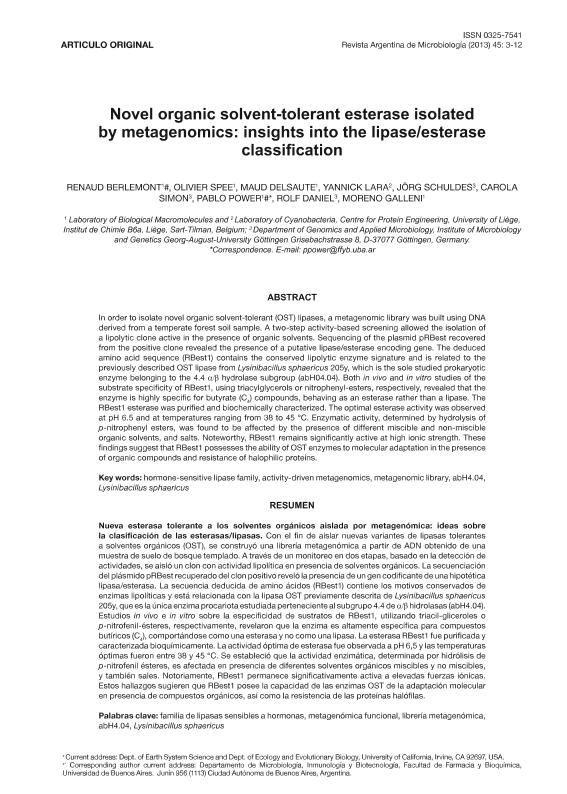Mostrar el registro sencillo del ítem
dc.contributor.author
Berlemont, Renaud
dc.contributor.author
Spee, Olivier
dc.contributor.author
Delsaute, Maud
dc.contributor.author
Lara, Yannick
dc.contributor.author
Schuldes, Jörg
dc.contributor.author
Simon, Carola
dc.contributor.author
Power, Pablo

dc.contributor.author
Daniel, Rolf
dc.contributor.author
Galleni, Moreno
dc.date.available
2017-01-10T21:07:09Z
dc.date.issued
2013-01
dc.identifier.citation
Berlemont, Renaud; Spee, Olivier; Delsaute, Maud; Lara, Yannick; Schuldes, Jörg; et al.; Novel organic solvent-tolerant esterase isolated by metagenomics: insights into the lipase/esterase classification; Asociación Argentina de Microbiología; Revista Argentina de Microbiología; 45; 1; 1-2013; 3-12
dc.identifier.issn
0325-7541
dc.identifier.uri
http://hdl.handle.net/11336/11095
dc.description.abstract
In order to isolate novel organic solvent-tolerant (OST) lipases, a metagenomic library was built using DNA derived from a temperate forest soil sample. A two-step activity-based screening allowed the isolation of a lipolytic clone active in the presence of organic solvents. Sequencing of the plasmid pRBest recovered from the positive clone revealed the presence of a putative lipase/esterase encoding gene. The deduced amino acid sequence (RBest1) contains the conserved lipolytic enzyme signature and is related to the previously described OST lipase from Lysinibacillus sphaericus 205y, which is the sole studied prokaryotic enzyme belonging to the 4.4 / hydrolase subgroup (abH04.04). Both in vivo and in vitro studies of the substrate specificity of RBest1, using triacylglycerols or nitrophenyl-esters, respectively, revealed that the enzyme is highly specific for butyrate (C4) compounds, behaving as an esterase rather than a lipase. The RBest1 esterase was purified and biochemically characterized. The optimal esterase activity was observed at pH 6.5 and at temperatures ranging from 38 to 45 °C. Enzymatic activity, determined by hydrolysis of p nitrophenyl esters, was found to be affected by the presence of different miscible and non-miscible organic solvents, and salts. Noteworthy, RBest1 remains significantly active at high ionic strength. These findings suggest that RBest1 possesses the ability of OST enzymes to molecular adaptation in the presence of organic compounds and resistance of halophilic proteins.
dc.description.abstract
Con el fin de aislar nuevas variantes de lipasas tolerantes a solventes orgánicos (OST), se construyó una librería metagenómica a partir de ADN obtenido de una muestra de suelo de bosque templado. A través de un monitoreo en dos etapas, basado en la detección de actividades, se aisló un clon con actividad lipolítica en presencia de solventes orgánicos. La secuenciación del plásmido pRBest recuperado del clon positivo reveló la presencia de un gen codificante de una hipotética lipasa/esterasa. La secuencia deducida de amino ácidos (RBest1) contiene los motivos conservados de enzimas lipolíticas y está relacionada con la lipasa OST previamente descrita de Lysinibacillus sphaericus 205y, que es la única enzima procariota estudiada perteneciente al subgrupo 4.4 de α/β hidrolasas (abH4.04). Estudios in vivo e in vitro sobre la especificidad de sustratos de RBest1, utilizando triacil-gliceroles o p-nitrofenil-ésteres, respectivamente, revelaron que la enzima es altamente específica para compuestos butíricos (C4 ), comportándose como una esterasa y no como una lipasa. La esterasa RBest1 fue purificada y caracterizada bioquímicamente. La actividad óptima de esterasa fue observada a pH 6,5 y las temperaturas óptimas fueron entre 38 y 45 °C. Se estableció que la actividad enzimática, determinada por hidrólisis de p-nitrofenil ésteres, es afectada en presencia de diferentes solventes orgánicos miscibles y no miscibles, y también sales. Notoriamente, RBest1 permanece significativamente activa a elevadas fuerzas iónicas. Estos hallazgos sugieren que RBest1 posee la capacidad de las enzimas OST de la adaptación molecular en presencia de compuestos orgánicos, así como la resistencia de las proteínas halófilas
dc.format
application/pdf
dc.language.iso
eng
dc.publisher
Asociación Argentina de Microbiología

dc.rights
info:eu-repo/semantics/openAccess
dc.rights.uri
https://creativecommons.org/licenses/by-nc-sa/2.5/ar/
dc.subject
Hormone-Sensitive Lipase Family
dc.subject
Activity-Driven Metagenomics
dc.subject
Abh4.04
dc.subject
Lysinibacillus Sphaericus
dc.subject.classification
Bioquímica y Biología Molecular

dc.subject.classification
Ciencias Biológicas

dc.subject.classification
CIENCIAS NATURALES Y EXACTAS

dc.title
Novel organic solvent-tolerant esterase isolated by metagenomics: insights into the lipase/esterase classification
dc.title
Nueva esterasa tolerante a los solventes orgánicos aislada por metagenómica: ideas sobre la clasificación de las esterasas/lipasas
dc.type
info:eu-repo/semantics/article
dc.type
info:ar-repo/semantics/artículo
dc.type
info:eu-repo/semantics/publishedVersion
dc.date.updated
2016-12-07T17:59:37Z
dc.identifier.eissn
1851-7617
dc.journal.volume
45
dc.journal.number
1
dc.journal.pagination
3-12
dc.journal.pais
Argentina

dc.journal.ciudad
Buenos Aires
dc.description.fil
Fil: Berlemont, Renaud. Universite de Liege; Bélgica
dc.description.fil
Fil: Spee, Olivier. Universite de Liege; Bélgica
dc.description.fil
Fil: Delsaute, Maud. Universite de Liege; Bélgica
dc.description.fil
Fil: Lara, Yannick. Universite de Liege; Bélgica
dc.description.fil
Fil: Schuldes, Jörg. Universitat of Gottingen; Alemania
dc.description.fil
Fil: Simon, Carola. Universitat of Gottingen; Alemania
dc.description.fil
Fil: Power, Pablo. Universite de Liege; Bélgica. Consejo Nacional de Investigaciones Científicas y Técnicas; Argentina
dc.description.fil
Fil: Daniel, Rolf. Universitat of Gottingen; Alemania
dc.description.fil
Fil: Galleni, Moreno. Universite de Liege; Bélgica
dc.journal.title
Revista Argentina de Microbiología

dc.relation.alternativeid
info:eu-repo/semantics/altIdentifier/url/http://ref.scielo.org/33dx6b
Archivos asociados
